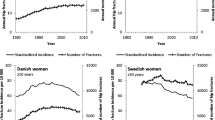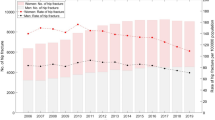Abstract
Summary
Hip fractures are substantial problem worldwide. The increase in rate with age does not continue into very old age. Rates decline in successive birth cohorts. If the increasing trend in period effect continues, there will be a substantial increase in hip fracture incidence.
Introduction
The purpose of this study is to (1) determine incidence rates for fracture neck of femur (FNF) for the period 1974-2007, (2) estimate age, cohort, and period effects, and (3) predict the burden of FNF in 2025.
Methods
Age adjusted incidence rates were estimated using New Zealand hospital discharge data for 1974-2007. Age-period-cohort modeling was used to estimate individual effects of these factors after adjusting for the other two factors. Future fracture burden was estimated under two scenarios.
Results
Age-adjusted rates for women increased from 1974 to 1987 whereas rates for men have increased from 1974 until 2007. Risk increased from 70 years of age but dropped among the very elderly. Period effects showed a steady increase in risk throughout 1974-2007. In contrast, the risk was lower in later cohorts. If there is no change in the period effect from 2007 we estimate a reduction in the burden of illness from FNF, especially for women. However if the period effect continues to increase, there will be substantial increases in FNF incidence, especially for men.
Conclusions
The effect of population aging on FNF incidence is predictable because projections are based on an existing population. The increasing health and improvement in measures of physical status of older people through the last century, explain the decline in FNF incidence in later cohorts. The steady increase in period effect may be due to increased survival of the very frail. This burden of illness resulting from FNFs must be addressed by population based, research proven approaches to fall and fracture prevention.



Similar content being viewed by others
References
Gullberg B, Johnell O, Kanis JA (1997) World-wide projections for hip fracture. Osteoporos Int 7(5):407–413
Kannus P, Niemi S, Parkkari J, Palvanen M, Vuori I, Jarvinen M (1999) Hip fractures in Finland between 1970 and 1997 and predictions for the future [see comment]. Lancet 353(9155):802–805
Martyn CN, Cooper C (1999) Prediction of burden of hip fracture [comment]. Lancet 353(9155):769–770
Stephenson S, Langley J, Campbell J, Gillespie W (2003) Upward trends in the incidence of neck of femur fractures in the elderly [comment]. N Z Med J 116(1185):U665
Langley JD, Stephenson S, Cryer C, Borman B (2002) Traps for the unwary in estimating person based injury incidence using hospital discharge data. Inj Prev 8:332–337
Holford TR (1991) Understanding the effect of age, period, and cohort on incidence and mortality rates. Annu Rev Public Health 12:425–457
Robertson C, Gandini S, Boyle P (1999) Age-period-cohort models: a comparative study of available methodologies. J Clin Epidemiol 52(6):569–583
McNally RJQ, Alexander FE, Staines A, Cartwright RA (1997) A comparison of three methods of analysis of age-period-cohort models with application to incidence data on non-Hodgkin's lymphoma. Int J Epidemiol 26(1):32–46
Yang Y, Fu WJ, Land KC (2004) A methodological comparison of age-period-cohort models: the intrinsic estimator and conventional generalized linear models. Sociol Method 34(1):75–110
STATA (2007) Stata Statistical Software: release 10. In: LP S, editor. College Station, Texas StataCorp
Johnell O, Kanis JA (2004) An estimate of the world wide prevalance, mortality and disability associated with hip fracture. Osteoporos Int 15:897–902
Schwenkglenks M, Lippuner K, Hauselmann HJ, Szucs Thomas D (2005) A model of osteoporosis impact in Switzerland 2000-2020. Osteoporos Int 16:659–671
Couris CM, Duclos A, Rabilloud M, Couray-Targe S, Ecochard R, Delmas PD et al (2007) A seventy percent overestimation of the burden of hip fractures in women aged 85 and over. Bone 41(5):896–900
Chang KP, Center JR, Nguyen TV, Eisman JA (2004) Incidence of Hip and other osteoporotic fractures in elderly men and women: Dubbo osteoporosis epidemiology study. J Bone Miner Res 19(4):532–536
Oeppen J, Vaupel JW (2002) Broken limits to life expectancy. Science 296:1029–1031
Sameison EJ, Zhang Y, Kiel D, Hannan MT, Felson D (2002) Effect of birth cohort on risk of hip fracture: age-specific incidence rates in the Farmingham study. Am J Public Health 92(5):858–862
Evans JG, Seagroatt V, Goldacre MJ (1997) Secular trends in proximal femoral fracture, Oxford record linkage study area and England 1968-86. J Epidemiol Community Health 51:424–429
Svanborg A (1988) The health of the elderly population: results from longitudinal studies with age-cohort comparisons. In: Evered D, Whelan J (eds) Research and the ageing population. Wiley, Chichester, pp 3–16
Yang Y, Lewis J, Epstein S, Metz D (2006) Long-term proton pump inhibitor therapy and risk of hip fracture. J Am Med Assoc 296(24):2947–2953
Jaglal SB, Weller I, Mamdani M, Hawker G, Kreder H, Jaakkimainen L et al (2005) Population trends in BMD testing, treatment, and hip and wrist fracture rates: are the hip fracture projections wrong? J Bone Miner Res 20(6):898–905
Nymark T, Lauritsen JM, Ovesen O, Rock ND, Jeune B (2006) Decreasing incidence of hip fracture in the Funen County, Denmark. Acta Orthopaedica 77(1):109–113
Campbell A, Robertson MC (2007) Rethinking individual and community fall prevention strategies: a meta-regression comparing single and multifactorial interventions. Age Ageing 36:656–662
Boufous S, Finch C, Close J, Day L, Lord S (2007) Hospital admissions following presentations to emergency departments for a fracture in older people. Inj Prev 13:211–214
Boufous S, Finch C (2005) Estimating the incidence of hospitalized injurious falls: impact of varying case definitions [erratum appears in Inj Prev. 2006 Apr;12(2):135]. Inj Prev 11(6):334–336
Du W, Hayen A, Finch C, Hatfield J (2008) Comparison of methods to correct the miscounting of multiple episodes of care when estimating the incidence of hospitalised injury in child motor vehicle passengers. Accident Anal Prev 40(4):1563–1568
Gedeborg R, Engquist H, Berglund L, Michaelsson K (2008) Identification of incident injuries in hospital discharge registers. Epidemiology 19(6):860–867
Kupper LL, Janis JM, Salama IA, Yoshizawa CN, Greenberg BG (1983) Age-Period-cohort analysis: an illustration of problems in assessing interaction in one observation per cell data. Commun Stat Theory Methods 12(23):2779–2807
Jackson JE (2003) A user's guide to principal components. Wiley, Hoboken
Jolliffe IT (1982) A note on the use of principal components regression. J R Stat Soc Ser C Appl Stat 31(3):300–303
Hadi AS, Ling RF (1998) Some cautionary notes on the use of principal components regression. Am Stat 52(1):15–19
Acknowledgments
We wish to thank Ministry of Health for providing the hospital discharge data and Statistics New Zealand for the population estimates.
Conflicts of interest
None.
Funding
This work was supported by the Health Research Council of New Zealand (07/052).
Author information
Authors and Affiliations
Corresponding author
Rights and permissions
About this article
Cite this article
Langley, J., Samaranayaka, A., Davie, G. et al. Age, cohort and period effects on hip fracture incidence: analysis and predictions from New Zealand data 1974-2007. Osteoporos Int 22, 105–111 (2011). https://doi.org/10.1007/s00198-010-1205-6
Received:
Accepted:
Published:
Issue Date:
DOI: https://doi.org/10.1007/s00198-010-1205-6




